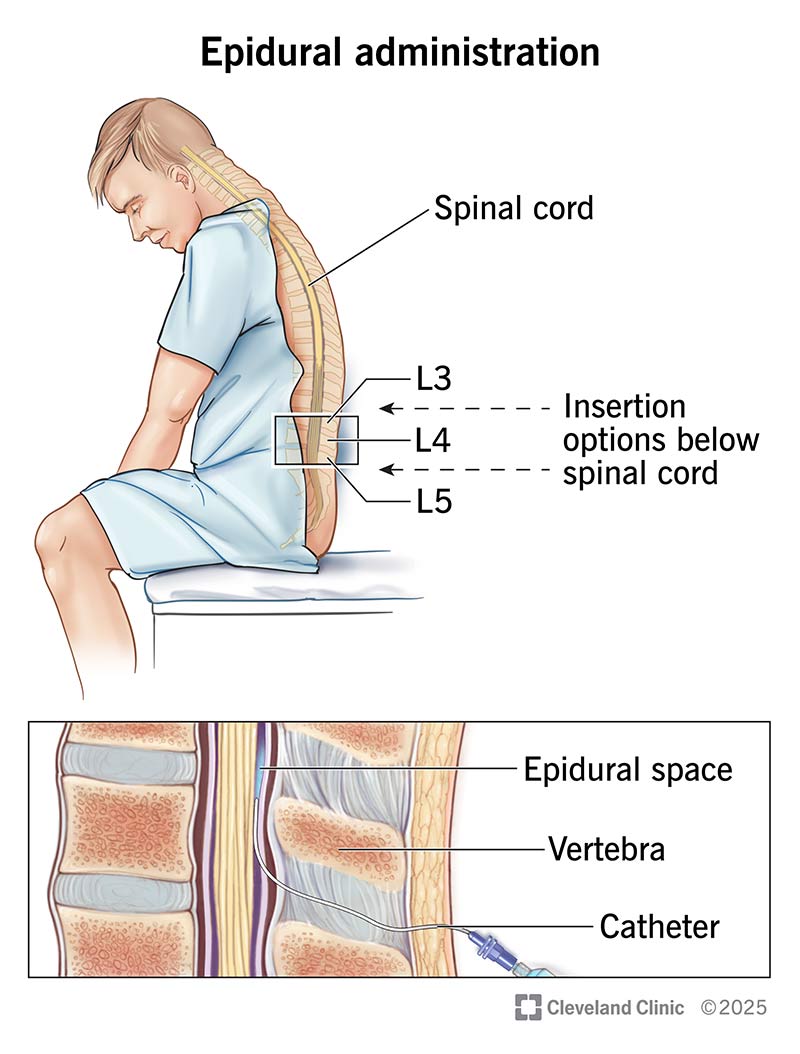Epidurals are injections near your spinal cord to relieve pain or deliver anesthesia. There are two types of epidural injections. Both are safe and effective. Your healthcare provider will tell you which kind you’ll need and what you can expect. Side effects and complications can happen, but they’re rare.
Advertisement
Cleveland Clinic is a non-profit academic medical center. Advertising on our site helps support our mission. We do not endorse non-Cleveland Clinic products or services. Policy

An epidural is an injection into the space around your spinal nerves that’s used for pain management. This area is the epidural space. That’s where epidurals get their name.
Advertisement
Cleveland Clinic is a non-profit academic medical center. Advertising on our site helps support our mission. We do not endorse non-Cleveland Clinic products or services. Policy
Epidurals can be used to manage a variety of issues, including:
There are two types of epidurals healthcare providers use for different situations:
How an epidural works depends on which type you need.
An epidural anesthesia stops pain signals from traveling from your spinal nerves to your brain. It safely and temporarily turns off the nerves. How long the effect lasts depends on how much medication your healthcare provider gives you.
Epidural steroid injections coat the irritated nerves that are causing pain. This reduces swelling and pressure on your affected nerves.
There are a few ways your provider can inject medication with an epidural, including:
Advertisement
What you need to do ahead of time can vary depending on which type of epidural you’re getting and why you need it. Your healthcare provider will give you specific prep instructions.
In general, you might have to:
What happens during an epidural depends on which type you need.
If you need a single-injection epidural, you’ll lie face down (on your stomach). Your provider will:
If you need an epidural with a catheter, the procedure will be a little different. For these, your provider will:
Advertisement
You’ll likely experience a minor pinch when your provider injects the local anesthetic to numb the area before the epidural procedure.
You may feel pressure, tingling, a burning sensation or momentary shooting pain when your provider injects the epidural. Or you may not feel anything. If you have any discomfort during the injection, it usually disappears once the injection is finished.
Tell your provider immediately if you feel intense, sharp pain during or after your epidural procedure.
Epidurals with anesthetic take 20 to 30 minutes to start working. Your provider will tell you what comes next if you’re having surgery or are in labor.
Epidural steroid injections start working in a few days. The pain relief should last a few months.
Epidurals are a safe, effective way to manage pain or give anesthesia.
Anesthetic epidurals are more flexible than other types of anesthesia, especially during labor. You can usually get an epidural any time during your labor if you need one. They often have milder side effects than other types of anesthesia.
Epidural steroid injections can help you resume daily activities that pain made you avoid. If it manages the pain well enough, you might avoid surgery or other invasive treatments.
Advertisement
Epidurals are usually safe, but there are risks of certain side effects and complications. Although rare, risks and complications can include:
There’s a common belief that getting an epidural will lead to back pain, but it’s very rare for an epidural to cause long-term or chronic back problems.
It’s normal to experience temporary back pain or tenderness at the site of your epidural. This usually goes away within a few days.
Many people who give birth experience back pain after labor and delivery — whether they’ve had an epidural or not. This is because the bones and ligaments in your pelvis shift back into their original positions from before your pregnancy. This can cause temporary back pain and discomfort.
How long the effects of an epidural last depends on which type you had and the exact medicine your healthcare provider injected. Your provider will let you know what to expect.
Advertisement
Don’t drive, operate machinery or drink alcohol for at least 24 hours after having an epidural. You might have to avoid certain physical activities and exercises for a day or two after an epidural.
Your healthcare provider will give you specific instructions about when you can return to your usual routine.
Call your healthcare provider or go to the emergency room if you experience any of the following symptoms after an epidural:
It might sound intimidating to have an injection near your spinal cord. But epidurals are a common, effective and safe way to deliver anesthesia or pain relief.
Don’t be afraid to ask your healthcare provider any questions you might have. They can tell you everything you need to know. They’ll explain which type of epidural is best for you, which medication they want to give you and how long you’ll feel the effects.
Cleveland Clinic childbirth experts coach you through every step — from labor to delivery to what to expect when you and your newborn head home.

Last reviewed on 05/02/2025.
Learn more about the Health Library and our editorial process.